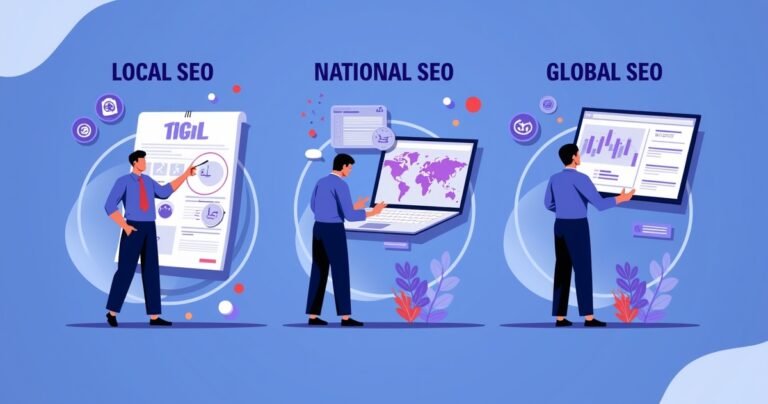How To Attract Visitors To The Website [2025 Updated]
In the ever-evolving digital landscape, attracting visitors to your website is more crucial than ever. As we approach 2025, understanding the dynamics of web traffic and leveraging cutting-edge strategies can set your website apart. This comprehensive guide will delve into the intricacies of attracting visitors, analyzing traffic, and converting those visitors into loyal customers. Whether you’re a seasoned digital marketer or a business owner looking to boost your online presence, this article will provide valuable insights and actionable steps to enhance your website’s performance.
Visitors to Website: Understanding Traffic Analysis
Understanding website traffic is the cornerstone of digital success. By analyzing traffic patterns, you can identify what attracts visitors and what keeps them engaged. Traffic analysis involves examining the sources of your website’s visitors, their behavior on your site, and the overall performance of your web pages.
Traffic Sources
Traffic sources are the origins from which visitors arrive at your website. These can include organic search, direct visits, referrals, and social media. By identifying which sources drive the most traffic, you can tailor your marketing strategies to capitalize on these channels.
- Organic Search : Visitors who find your site through search engines.
- Direct Visits : Users who type your URL directly into their browser.
- Referrals : Traffic from other websites linking to yours.
- Social Media : Visitors arriving from social media platforms.
Visitor Demographics
Understanding who your visitors are can help you tailor your content and marketing strategies. Demographics such as age, gender, location, and interests provide insights into your audience’s preferences and behaviors.
- Age and Gender : Identify the age group and gender that most frequently visits your site.
- Location : Determine the geographical areas where your visitors are concentrated.
- Interests : Analyze the interests and preferences of your audience.
Traffic Patterns
Analyzing traffic patterns helps you understand when and how visitors interact with your site. This includes peak visit times, bounce rates, and session durations.
- Peak Visit Times : Identify the times of day when your site receives the most traffic.
- Bounce Rates : Measure the percentage of visitors who leave your site after viewing only one page.
- Session Durations : Track how long visitors stay on your site during each visit.
Competitor Website Traffic Analysis
Analyzing your competitors’ website traffic can provide valuable insights into their strategies and performance. By understanding what works for them, you can refine your own approach to attract more visitors.
Tracking Competitor Traffic Volume
Monitoring the traffic volume of competitor websites can reveal their market reach and popularity. Tools like SimilarWeb and SEMrush can help you estimate the number of visitors your competitors receive.
- Traffic Estimation Tools : Use tools to gauge competitor traffic.
- Market Reach : Assess the extent of your competitors’ audience.
- Popularity Metrics : Analyze the popularity of competitor content.
Identifying Top-Performing Content
Discovering which content performs best for your competitors can inform your content strategy. Look for patterns in the type of content that attracts the most visitors.
- Content Analysis : Examine the topics and formats that drive traffic.
- Engagement Metrics : Analyze likes, shares, and comments on competitor content.
- Content Gaps : Identify opportunities where your content can fill unmet needs.
Keyword-Driven Website Visitors
Keywords play a pivotal role in attracting visitors through search engines. By optimizing your content for relevant keywords, you can increase your website’s visibility and attract more organic traffic.
Organic Search Traffic
Organic search traffic refers to visitors who find your website through unpaid search engine results. Optimizing your site for search engines involves using relevant keywords, creating high-quality content, and ensuring a user-friendly experience.
- Keyword Research : Identify keywords that your target audience is searching for.
- On-Page SEO : Optimize titles, meta descriptions, and headers with keywords.
- Content Quality : Create valuable and informative content that answers user queries.
Paid Traffic Strategies
Paid traffic strategies involve using advertising platforms to drive visitors to your website. This can include pay-per-click (PPC) campaigns, social media ads, and display advertising.
- PPC Campaigns : Use platforms like Google Ads to target specific keywords.
- Social Media Advertising : Leverage platforms like Facebook and Instagram for targeted ads.
- Display Advertising : Use banner ads on relevant websites to attract visitors.
Bulk Website Traffic Checking Tools
Bulk website traffic checking tools allow you to analyze multiple websites simultaneously. These tools provide insights into traffic volume, sources, and engagement metrics.
Traffic Analysis Tools
Several tools can help you analyze website traffic in bulk, providing a comprehensive view of your online presence and that of your competitors.
- Google Analytics : Offers detailed insights into your website’s traffic and user behavior.
- SEMrush : Provides traffic analysis and competitive research.
- Ahrefs : Offers tools for analyzing traffic, backlinks, and keywords.
Engagement Metrics
Engagement metrics help you understand how visitors interact with your website. These metrics include page views, time on site, and conversion rates.
- Page Views : Track the number of pages viewed per visit.
- Time on Site : Measure how long visitors stay on your site.
- Conversion Rates : Calculate the percentage of visitors who complete desired actions.
Comparative Analysis
Comparative analysis involves comparing your website’s performance with that of your competitors. This can help you identify areas for improvement and opportunities for growth.
- Benchmarking : Compare your traffic metrics with industry standards.
- Performance Gaps : Identify areas where your site lags behind competitors.
- Growth Opportunities : Discover new strategies to increase traffic.
Improving Website Security for Visitors
Website security is crucial for protecting your visitors’ data and maintaining their trust. Implementing robust security measures can enhance your website’s reputation and attract more visitors.
SSL Certificates
SSL certificates encrypt data transmitted between your website and its visitors, ensuring secure communication. This is essential for protecting sensitive information and building trust.
- Data Encryption : Protects data from being intercepted by malicious actors.
- Trust Signals : Display security badges to reassure visitors.
- SEO Benefits : Secure sites may receive a ranking boost from search engines.
Regular Security Audits
Conducting regular security audits helps identify vulnerabilities and ensure your website remains secure. This involves scanning for malware, updating software, and monitoring for suspicious activity.
- Malware Scanning : Detect and remove malicious software.
- Software Updates : Keep your website’s software up to date.
- Activity Monitoring : Track and respond to unusual activity.
User Data Protection
Protecting user data involves implementing privacy policies and ensuring compliance with data protection regulations. This helps build trust and encourages visitors to engage with your site.
- Privacy Policies : Clearly communicate how user data is collected and used.
- Regulatory Compliance : Adhere to data protection laws like GDPR.
- User Consent : Obtain consent before collecting personal information.
Analyzing Visitor Behavior and Engagement
Understanding visitor behavior and engagement is key to optimizing your website’s performance. By analyzing how visitors interact with your site, you can identify areas for improvement and enhance the user experience.
Time Spent on Site
The amount of time visitors spend on your site is an indicator of engagement. Longer visit durations suggest that visitors find your content valuable and engaging.
- Content Quality : Create engaging and informative content to keep visitors on your site.
- User Experience : Ensure a seamless and enjoyable browsing experience.
- Interactive Elements : Use videos, quizzes, and other interactive elements to engage visitors.
Page Views per Visit
Page views per visit measure how many pages a visitor views during a single session. Higher page views indicate that visitors are exploring your site and finding value in your content.
- Internal Linking : Use internal links to guide visitors to related content.
- Content Organization : Organize content logically to encourage exploration.
- Engaging Visuals : Use images and videos to enhance content and encourage exploration.
Bounce Rate
Bounce rate measures the percentage of visitors who leave your site after viewing only one page. A high bounce rate may indicate that visitors are not finding what they’re looking for.
- Relevant Content : Ensure content matches visitor expectations.
- Clear Navigation : Make it easy for visitors to find what they’re looking for.
- Fast Loading Times : Optimize site speed to reduce bounce rates.
Converting Website Visitors to Customers
Converting visitors into customers is the ultimate goal of any website. By optimizing landing pages and using effective strategies, you can increase conversion rates and drive sales.
Optimizing Landing Pages
Landing pages are the first impression visitors have of your site. Optimizing these pages can significantly impact conversion rates.
- Clear Messaging : Communicate your value proposition clearly.
- Compelling Visuals : Use images and videos to capture attention.
- User-Friendly Design : Ensure a seamless and intuitive user experience.
Call-to-Action Strategies
Effective call-to-action (CTA) strategies encourage visitors to take desired actions, such as making a purchase or signing up for a newsletter.
- Action-Oriented Language : Use strong verbs to prompt action.
- Prominent Placement : Position CTAs where they are easily visible.
- Incentives : Offer discounts or free trials to encourage action.
A/B Testing
A/B testing involves comparing two versions of a webpage to determine which performs better. This can help you optimize elements like headlines, images, and CTAs.
- Headline Testing : Experiment with different headlines to see which resonates.
- Image Testing : Test different images to see which captures attention.
- CTA Testing : Compare different CTAs to determine which drives more conversions.
Measuring Economic Impact of Website Visitors
Understanding the economic impact of website visitors can help you assess the value of your online presence. This involves measuring direct visitor spending and the total economic impact.
Direct Visitor Spending
Direct visitor spending refers to the revenue generated from visitors who make purchases on your site. This is a key metric for assessing the financial performance of your website.
- Sales Tracking : Monitor sales generated from website visitors.
- Revenue Analysis : Analyze revenue trends to identify growth opportunities.
- Customer Lifetime Value : Calculate the long-term value of customers acquired through your site.
Total Economic Impact
The total economic impact includes both direct and indirect effects of website visitors. This can include increased brand awareness, customer referrals, and repeat business.
- Brand Awareness : Measure the impact of website visitors on brand recognition.
- Customer Referrals : Track referrals generated by satisfied customers.
- Repeat Business : Analyze the impact of repeat visitors on revenue.
ROI Analysis
Return on investment (ROI) analysis helps you assess the profitability of your website. This involves comparing the costs of maintaining your site with the revenue generated from visitors.
- Cost Analysis : Calculate the costs of website maintenance and marketing.
- Revenue Comparison : Compare revenue with costs to determine profitability.
- Performance Metrics : Use metrics like ROI to assess website performance.
Enhancing User Experience for Website Visitors
Enhancing the user experience is crucial for attracting and retaining visitors. By optimizing your site for mobile devices and improving site speed, you can create a seamless and enjoyable experience for your audience.
Mobile Optimization
With the increasing use of mobile devices, optimizing your site for mobile is essential. This involves ensuring your site is responsive and easy to navigate on smaller screens.
- Responsive Design : Use a design that adapts to different screen sizes.
- Mobile-Friendly Navigation : Simplify navigation for mobile users.
- Touch-Friendly Elements : Ensure buttons and links are easy to tap on mobile devices.
Site Speed Improvements
Site speed is a critical factor in user experience. Faster loading times can reduce bounce rates and improve visitor satisfaction.
- Image Optimization : Compress images to reduce loading times.
- Caching : Use caching to speed up page loading.
- Minimize HTTP Requests : Reduce the number of requests to improve speed.
Accessibility
Ensuring your site is accessible to all users, including those with disabilities, is important for providing a positive user experience.
- Alt Text for Images : Use descriptive alt text for images.
- Keyboard Navigation : Ensure your site can be navigated using a keyboard.
- Screen Reader Compatibility : Make your site compatible with screen readers.
FAQs
How can I increase visitors to my website?
To increase visitors to your website, focus on optimizing your content for search engines and leveraging social media platforms. Additionally, consider using paid advertising to reach a wider audience and attract more visitors.
What tools can I use to track website visitors?
You can use tools like Google Analytics, SEMrush, and Ahrefs to track website visitors. These tools provide insights into traffic sources, visitor behavior, and engagement metrics, helping you understand your audience better.
How do I analyze website visitor data effectively?
To analyze website visitor data effectively, focus on key metrics such as traffic sources, bounce rates, and conversion rates. Use tools like Google Analytics to gain insights into visitor behavior and identify areas for improvement.
What metrics should I focus on for website visitors?
Focus on metrics such as page views, time on site, and conversion rates to understand visitor engagement. Additionally, monitor bounce rates and traffic sources to identify areas for optimization.
How can I convert more website visitors into customers?
To convert more website visitors into customers, optimize your landing pages and use effective call-to-action strategies. Additionally, consider using A/B testing to refine your approach and improve conversion rates.






